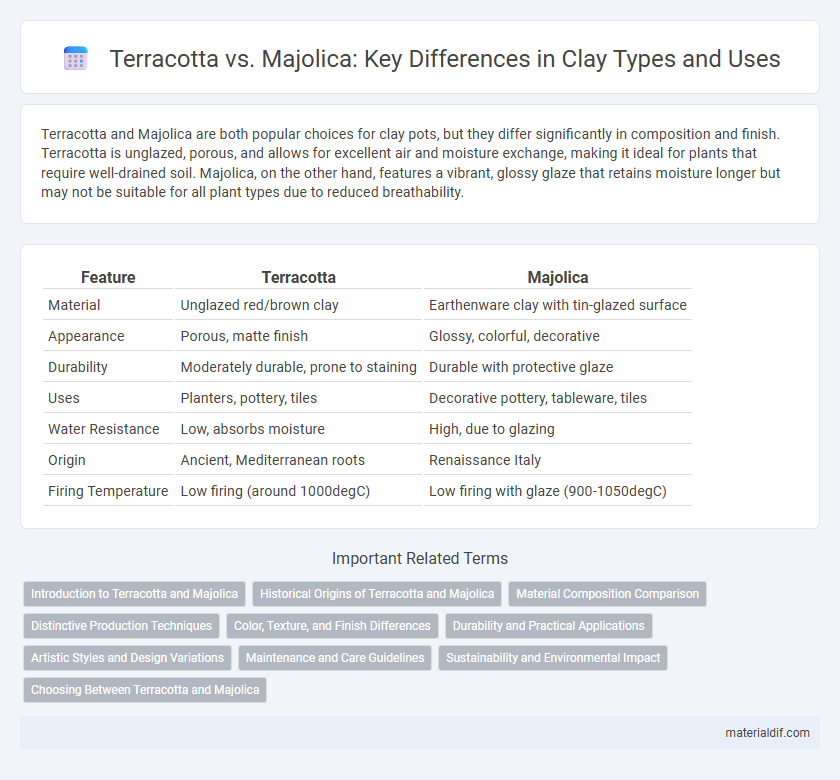Terracotta and Majolica are both popular choices for clay pots, but they differ significantly in composition and finish. Terracotta is unglazed, porous, and allows for excellent air and moisture exchange, making it ideal for plants that require well-drained soil. Majolica, on the other hand, features a vibrant, glossy glaze that retains moisture longer but may not be suitable for all plant types due to reduced breathability.
Table of Comparison
| Feature | Terracotta | Majolica |
|---|---|---|
| Material | Unglazed red/brown clay | Earthenware clay with tin-glazed surface |
| Appearance | Porous, matte finish | Glossy, colorful, decorative |
| Durability | Moderately durable, prone to staining | Durable with protective glaze |
| Uses | Planters, pottery, tiles | Decorative pottery, tableware, tiles |
| Water Resistance | Low, absorbs moisture | High, due to glazing |
| Origin | Ancient, Mediterranean roots | Renaissance Italy |
| Firing Temperature | Low firing (around 1000degC) | Low firing with glaze (900-1050degC) |
Introduction to Terracotta and Majolica
Terracotta, a porous clay-based ceramic, is traditionally fired at low temperatures, resulting in a natural reddish-brown color ideal for pottery and architectural elements. Majolica is a type of tin-glazed pottery characterized by its vibrant, glossy surface achieved through a white opaque glaze layered with colorful, intricate designs. Both materials highlight unique firing techniques and surface treatments, distinguishing terracotta's earthy texture from majolica's decorative brilliance.
Historical Origins of Terracotta and Majolica
Terracotta originated in ancient civilizations such as Mesopotamia and the Indus Valley around 10,000 years ago, characterized by its porous, reddish-brown clay used for pottery, sculptures, and architectural elements. Majolica, developed during the Renaissance in Italy, involves tin-glazed earthenware with a white, opaque surface decorated with vibrant colors, reflecting advancements in glazing techniques that transformed mundane terracotta vessels into highly decorative art pieces. The historical progression from simple terracotta to elaborately painted majolica highlights evolving clay treatment methods influenced by cultural and technological developments in Europe.
Material Composition Comparison
Terracotta clay is primarily composed of earthenware with a high iron content, giving it its characteristic reddish-brown color after firing, whereas Majolica is a tin-glazed earthenware known for its white, opaque surface ideal for vibrant painted decoration. Terracotta typically maintains a porous and unglazed finish, making it suitable for sculptural and structural uses, while Majolica's glaze provides a non-porous surface that enhances durability and decorative appeal. The firing temperature of Terracotta ranges between 1000degC to 1150degC, lower than Majolica's, which often requires careful glaze firing to achieve its glossy, colorful finish.
Distinctive Production Techniques
Terracotta is crafted through a low-fire technique using porous clay, typically unglazed or coated with a matte slip, emphasizing its natural earthy texture. Majolica employs a high-fire process featuring a tin-oxide glaze that creates a glossy, opaque white surface ideal for vibrant, detailed painted designs. The primary distinction lies in terracotta's raw, rustic finish contrasted with majolica's smooth, vividly decorated ceramic appearance.
Color, Texture, and Finish Differences
Terracotta offers a warm, earthy color palette with rustic textures and a matte, porous finish ideal for natural, unglazed applications. Majolica, conversely, features vibrant, glossy finishes with smooth textures and intricate painted designs achieved through tin-glazed earthenware techniques. The differences in color intensity, surface texture, and finish distinguish terracotta's organic aesthetic from majolica's decorative and polished appearance.
Durability and Practical Applications
Terracotta, a porous and unglazed clay material, offers moderate durability suitable for outdoor garden pots and architectural elements but requires sealing to prevent water absorption and cracking. Majolica, characterized by its tin-glazed surface, provides enhanced durability and resistance to moisture, making it ideal for decorative tiles, tableware, and indoor applications vulnerable to wear. Its non-porous finish ensures longevity and ease of cleaning, outperforming terracotta in practical uses requiring waterproof and aesthetic qualities.
Artistic Styles and Design Variations
Terracotta features earthy, rustic tones and unglazed or matte finishes, emphasizing natural textures and traditional, folk-inspired motifs often seen in pottery and architectural elements. Majolica is characterized by vibrant, glossy glazes with intricate painted designs, showcasing a wide palette of colors and detailed patterns influenced by Renaissance and Mediterranean artistic styles. The design variations in terracotta lean towards organic forms and simplicity, whereas majolica highlights elaborate decoration and bright, eye-catching aesthetics.
Maintenance and Care Guidelines
Terracotta requires regular sealing to prevent moisture absorption and staining, with cleaning limited to mild soap and water to avoid surface damage. Majolica, glazed and less porous, demands gentle cleaning to preserve its vibrant patterns, avoiding abrasive materials that can scratch the glaze. Both materials benefit from avoiding rapid temperature changes to prevent cracking and prolong their lifespan.
Sustainability and Environmental Impact
Terracotta offers superior sustainability due to its natural clay composition and minimal processing requirements, resulting in a lower carbon footprint compared to majolica, which involves additional glazing and firing stages that increase energy consumption. The unglazed porous nature of terracotta also promotes biodegradability and reduces synthetic chemical use, unlike majolica's lead or tin-based glazes that pose environmental hazards. Terracotta's durability and ability to absorb water in gardening applications further contribute to eco-friendly practices by conserving resources and supporting natural plant growth cycles.
Choosing Between Terracotta and Majolica
Choosing between terracotta and majolica depends on the intended use and aesthetic preference, as terracotta offers a porous, rustic finish ideal for planting and outdoor decor, while majolica features a glossy, colorful glaze perfect for decorative pottery and tableware. Terracotta's natural reddish-brown clay provides durability and breathability, whereas majolica's tin-glazed surface allows for intricate, vibrant designs but requires careful handling to avoid chipping. Evaluating factors like exposure to moisture, desired color vibrancy, and functional purpose helps determine the best choice for specific clay projects.
Terracotta vs Majolica Infographic

 materialdif.com
materialdif.com